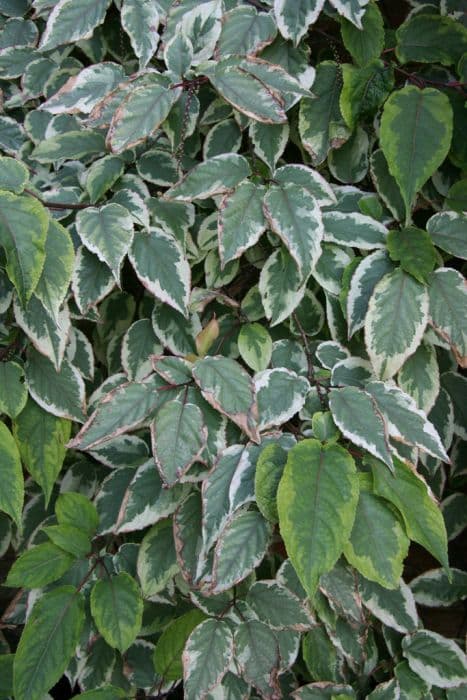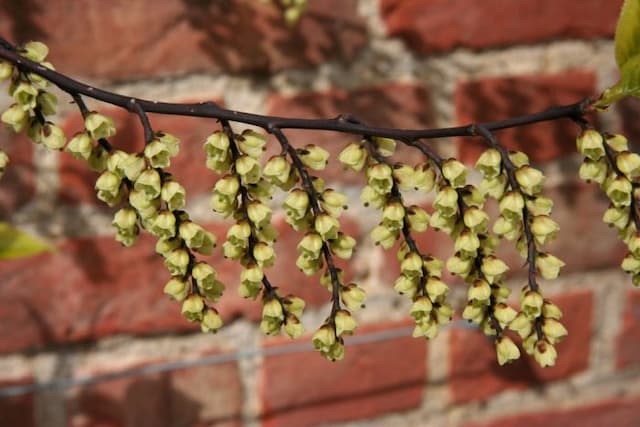Chinese Stachyurus Stachyurus chinensis

ABOUT
The Chinese Stachyurus is a striking plant renowned for its unique and attractive features. This plant showcases a beautiful array of cascading, raceme-like flower clusters that dangle neatly from its branches. During the blooming phase, these flower clusters consist of small, bell-shaped flowers with a delightful yellow hue that imparts a vibrant splash of color to the plant. The flowers emerge in early spring, bringing a much-anticipated display of color after the dormant winter months. As for the foliage, the leaves of the Chinese Stachyurus are narrow and have an elongated oval shape, presenting a bright green color that transitions to an eye-catching yellow or sometimes a warm, bronzed tone in the fall, adding another layer of seasonal interest. These leaves are alternately arranged on the branches, creating a lush, full look that complements the delicate flowers. The plant also has a notable bark that provides winter interest. As it matures, the bark exfoliates to reveal patches that can have a variety of textures and colors, adding to its ornamental appeal throughout the year. Overall, the Chinese Stachyurus is a plant that captivates with its pendulous flower clusters, vibrant foliage, and interesting bark, offering multiseasonal interest and making it a delightful addition to gardens where its beauty can be appreciated.
About this plant
 Names
NamesFamily
Stachyuraceae
Synonyms
Chinese Stachyurus, Spiketail
Common names
Stachyurus himalaicus, Stachyurus praecox var. chinensis.
 Toxicity
ToxicityTo humans
The Stachyurus chinensis, commonly known as Chinese stachyurus, is not widely recognized for its toxicity to humans. There is limited information available regarding its potential poisonous properties. Therefore, it's generally considered non-toxic. However, as with any plant, individual allergic reactions or sensitivities could occur, and it is generally advisable to avoid ingesting parts of ornamental plants due to the potential risks.
To pets
Chinese stachyurus is not known to be toxic to pets. Similar to its effects on humans, there is limited information suggesting any widespread toxicity of Stachyurus chinensis to domestic animals. Pets should still be discouraged from eating ornamental plants as a precaution, but there are no specific symptoms of poisoning associated with this plant documented in common sources. Always be cautious and monitor pets for any signs of distress after ingesting unknown plants and consult a vet if you observe any adverse reactions.
 Characteristics
CharacteristicsLife cycle
Perennials
Foliage type
Deciduous
Color of leaves
Green
Flower color
Yellow
Height
6-10 feet [1.8-3 meters]
Spread
4-8 feet [1.2-2.4 meters]
Plant type
Shrub
Hardiness zones
5
Native area
China
Benefits
 General Benefits
General Benefits- Landscape Aesthetics - Stachyurus chinensis, commonly known as Chinese stachyurus, adds visual interest to gardens with its hanging, bell-shaped flowers and unique foliage.
- Seasonal Interest - This plant provides year-round interest with its flowers in spring, lush green leaves in summer, and yellow to red foliage in autumn.
- Wildlife Attraction - The flowers of Chinese stachyurus may attract pollinators, such as bees and butterflies, enhancing biodiversity.
- Drought Tolerance - Once established, it is relatively drought tolerant, reducing the need for frequent watering.
- Low Maintenance - Chinese stachyurus generally requires little pruning or other care, making it suitable for low-maintenance landscapes.
- Cold Hardiness - It can tolerate cold temperatures, making it a suitable ornamental plant for temperate regions.
- Non-Invasive - As it is not known to be invasive, planting Chinese stachyurus can be done without concern for unintended spread.
 Medical Properties
Medical PropertiesThis plant is not used for medical purposes.
 Air-purifying Qualities
Air-purifying QualitiesThis plant is not specifically known for air purifying qualities.
 Other Uses
Other Uses- As a natural dye: The leaves and berries of Stachyurus chinensis may be used to produce natural dyes for fabrics or artworks.
- In bonsai culture: This plant can be trained into a bonsai form, making it a unique choice for enthusiasts of miniature tree art.
- As a living fence: When planted in a row, Stachyurus chinensis can create a dense, living barrier that provides privacy and wind protection.
- For educational purposes: Botanical gardens and educational institutions may use Stachyurus chinensis to teach about plant morphology and botany, due to its distinct flower racemes.
- As an ornamental feature in rain gardens: The plant's adaptability to moist conditions makes it suitable for use in rain gardens, which are designed to absorb rainwater runoff.
- As a compost ingredient: The leaves and branches, when pruned, can be added to compost heaps to enrich the organic matter in the soil.
- For winter interest: The unique pendulous racemes of Stachyurus chinensis can add visual interest to a garden during the dormant winter months.
- Leaf castings: Craft enthusiasts might use the plant's leaves to make decorative leaf castings for garden ornaments or art projects.
- Photography subject: The distinct form and early spring blossoms of Stachyurus chinensis make it a favorite subject for garden photographers.
- In floral arrangements: Although not common, the flowering branches could be cut and used in large-scale, rustic floral arrangements.
Interesting Facts
 Feng Shui
Feng ShuiThe Chinese Stachyurus is not used in Feng Shui practice.
 Zodiac Sign Compitability
Zodiac Sign CompitabilityThe Chinese Stachyurus is not used in astrology practice.
 Plant Symbolism
Plant Symbolism- Grace and Elegance: Stachyurus chinensis, commonly known as Chinese Stachyurus, often represents grace and elegance due to its dangling racemes of bell-shaped flowers that provide a delicate and sophisticated appearance in early spring.
- Rarity and Uniqueness: Because it's not as commonly known or found in gardens as other plants, the Chinese Stachyurus can symbolize rarity and uniqueness in the plant world.
- Renewal: The Chinese Stachyurus blooms in early spring, making it a symbol of renewal and the cycle of life as it is one of the first plants to announce the end of winter.
- Adaptation: It has the ability to grow in a variety of soil conditions, which can symbolize adaptability and resilience in different environments.
 Water
WaterFor your Chinese Stachyurus, it's essential to maintain consistent moisture without overwatering. Generally, water this plant when the top inch of soil feels dry, which might equate to watering approximately once a week. During the growing season, water it with about 1 gallon every week, but adjust the amount based on weather conditions such as temperature and rainfall. In the dormant winter period, reduce watering frequency as the plant requires less moisture. Always ensure that the plant has good drainage to prevent root rot.
 Light
LightChinese Stachyurus thrives best in partial shade, where it receives filtered sunlight or morning sun followed by afternoon shade. An ideal spot would shield it from intense, direct afternoon sunlight which can be too harsh. If grown indoors, place it near a window where soft, ambient light is prevalent throughout the day.
 Temperature
TemperatureChinese Stachyurus can handle a range of temperatures but prefers moderate conditions. The ideal temperature range for this plant is between 60°F and 80°F. It can survive minimum temperatures down to approximately 20°F, but growth will be best if it's not exposed to such cold climates for extended periods.
 Pruning
PruningPrune Chinese Stachyurus to shape it and control its size, as well as to remove any dead or damaged branches. Pruning is best done in late winter or early spring before new growth begins, and it can be done annually. Focus on thinning out crowded areas to ensure adequate airflow and light penetration, which promotes overall plant health.
 Cleaning
CleaningAs needed
 Soil
SoilChinese Stachyurus thrives in well-draining, humus-rich soil with a slightly acidic to neutral pH, ideally between 5.5 and 7. A mix containing garden soil, peat moss, and perlite or coarse sand would provide the necessary drainage and fertility for healthy growth.
 Repotting
RepottingChinese Stachyurus doesn't require frequent repotting and should be repotted every 2-3 years or when it outgrows its current container. It's best to repot in the spring before new growth begins.
 Humidity & Misting
Humidity & MistingChinese Stachyurus prefers moderate to high humidity levels, generally around 50-70%. In dry climates, increasing ambient humidity with humidity trays or room humidifiers can be beneficial.
 Suitable locations
Suitable locationsIndoor
Provide bright, indirect light and maintain humidity.
Outdoor
Place in partial shade, shelter from strong winds.
Hardiness zone
6-9 USDA
 Life cycle
Life cycleStachyurus chinensis, commonly known as the Chinese Stachyurus, begins its life as a seed which germinates in early spring, given appropriate warm and moist conditions. The seedling then develops into a young plant with a primary root system, and shoots emerge to start the vegetative growth phase. As the plant matures, it forms a woody structure with characteristic simple leaves that have a serrated margin. During late winter to early spring, before the foliage fully unfolds, it produces unique, pendulous racemes of small, bell-shaped yellow flowers. Following pollination, usually by insects, the plant sets fruit which are dry capsules that eventually release the seeds, completing the reproductive cycle. The Chinese Stachyurus can continue to live for many years, following a perennial growth habit and going through the same cycle seasonally, with dormant periods over the winter when the plant shows little to no growth.
 Propogation
PropogationPropogation time
Spring
The most popular method of propagating the Chinese Stachyurus (Stachyurus chinensis) is through semi-hardwood cuttings. This process typically occurs in late summer. To propagate, one would take a cutting from the current year’s growth that has begun to mature but is not fully hardened. The cutting should be about 4 to 6 inches (approximately 10 to 15 centimeters) long and have several leaves. Remove the leaves from the lower half of the cutting and dip the cut end into a rooting hormone powder to encourage root development. Then, place the prepared cutting into a pot filled with a mix of peat and perlite, ensuring the leafless part is buried. The pot should be kept under a light shade and misted regularly to maintain high humidity until the cutting has rooted, which can be checked by gently tugging on the cutting after a few weeks to feel for resistance.


